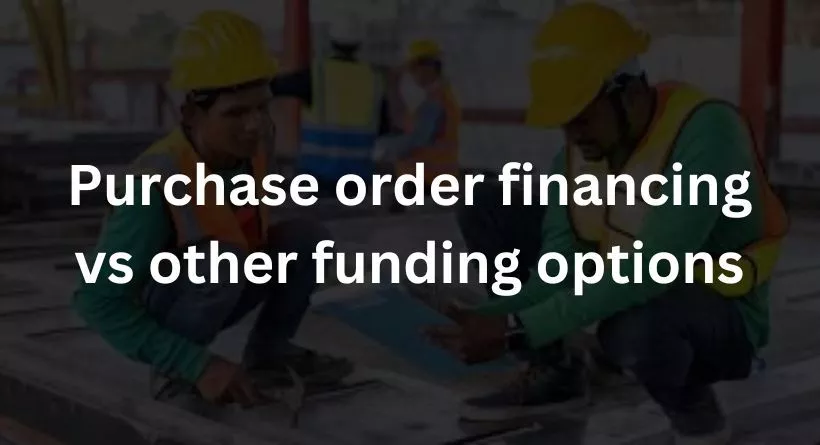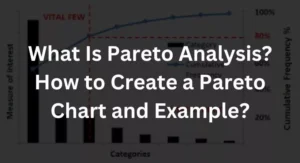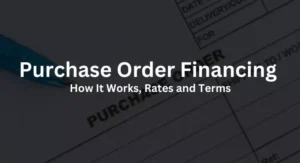
Although most businesses wish and expect for a big contract to come in, the reality is that it might cause financial strain. Upon receiving a purchase order from their client, a contractor or supplier must make the necessary material purchases to begin project work or production. However, because they are awaiting payments from other clients and projects, they might not have the money on hand to pay for the purchase of goods. Purchase order financing is a tool that certain construction businesses use to pay for supplies without having to use their own funds. This is how it operates.
What is purchase order financing?

A financial advance used to cover a supplier’s manufacturing expenses for a sanctioned order is known as purchase order financing. The supplier receives the funding from the third-party finance firm in order to assemble or produce the goods.
According to Mobilization Funding CEO Scott Peper, “‘Traditional’ PO financing is when a company is financing finished goods only, meaning they are buying a finished good from a supplier and delivering that finished good to their end customer.”
But according to Scott, the phrase “purchase order financing” is now used to describe a broad range of operations. For instance, “PO financing” is occasionally used in the construction industry to describe materials financing, when a financing firm pays the building material supplier directly for the demands of a contractor’s project.
Traditional purchase order financing businesses look more at the supplier than the buyer when assessing their financial risk. According to Scott, “the PO company heavily relies on the supplier’s track record and ability to produce the product.” This shifts performance risk from the consumer, who usually bears just the installation costs, to the supplier that makes the product.
PO finance businesses sometimes depend more on the project’s overall creditworthiness or the creditworthiness of the eventual client when utilized in construction than they do on the contractor or even the supplier. Because of this, a larger range of suppliers and contractors—including those who are just getting started and don’t have a long credit history—can apply for PO financing.
You may also like reading: Purchase Order Financing: How It Works, Rates and Terms
Who uses purchase order financing?
Anyone in need of purchasing tangible commodities, such as roofing shingles or construction materials, can apply for purchase order financing. (On occasion, it can also be used to pay for the purchase or leasing of equipment.) In building, these consist of:
- Distributors and suppliers of raw materials: These businesses must buy inventories or raw materials for production.
- Fabricators: In order to fabricate, they must buy raw materials.
- Subcontractors: In order to carry out their task, they must buy supplies or machinery.
- Companies that rent out equipment must buy new or old equipment to provide to their clients.
Construction labor and mobilization are examples of services that are not covered by purchase order financing. Financing alternatives for contractors might also assist cover additional expenses like overhead. Rather, PO finance is reserved especially for paying for supplies or machinery.
How purchase order financing works in construction
Here’s an illustration of buy order finance in operation for a building project:
- A GC and a roofing contractor agree on a $2 million contract for the installation of a new roof on a commercial property. They will need to spend $750K on supplies in order to finish the project.
- In order to do the project, the roofing business makes an itemized inventory of the supplies they’ll need, including underlayment, metal roofing panels, flashing, sealer, etc. They give their neighborhood dealer of roofing materials a purchase order.
- However, the roofing contractor does not have the $500K necessary to complete the order since they only have a $250K credit line with the distributor. Thus, the finance business receives an application for purchase order financing from the contractor or supplier.
- The finance firm reviews the project data, including the payment history of the general contractor. Once the financing is granted, the supplier receives a cheque from the finance business or occasionally a certified letter of credit.
- The contractor builds the roof successfully after the distributor brings the roofing supplies to the worksite.
- After sending the GC a pay application for the labor and supplies, the contractor waits for payment.
- The request is granted by the GC, who also gives the $2 million check to the roofing contractor.
- The contractor pays $500K to the finance business (and $250K to the supplier) after the check clears.
In this instance, the roofing contractor was able to conserve their own money to pay for overhead and labor costs during the project by using PO financing to finish their largest job to yet.
How much does PO financing cost?
PO financing normally costs two to eight percent of the order value. The amount of purchase order financing is determined by several elements, such as the job’s risk level, order size, number of funded POs, payback period, and length of time.
That cost is usually paid throughout the duration of the project rather than being paid entirely at once. For a maximum of four months, the contractor could be required to pay the finance business a modest weekly payment in addition to an origination charge.
The benefit of finishing more or larger contracts outweighs the cost of financing a material acquisition for enterprises looking to expand their construction business.
Purchase order financing vs other funding options

Credit cards
Most contractors find it simple to obtain credit cards, but they might be costly if your credit history isn’t the finest. Compared to PO financing, interest rates are substantially higher and can reach up to 29%, in addition to various costs. Although they are widely recognized by businesses and are simple to use, using them might get you into trouble. Additionally, you need to have excellent credit or a long-standing connection with the issuer in order to pay for major expenditures.
Line of credit
Your bank account’s safety net is a line of credit. When you need money, you can take it out of the account; just the amount you take out will be subject to interest. It can also be used to account overdrafts. But banks aren’t the only place where you can get it. Material suppliers usually offer trade credit, or a line of credit, to eligible clients.
Obtaining a line of credit requires time and an application procedure that involves a credit check and a review of financial statements. Purchase order financing usually happens considerably more quickly and is not contingent on the applicant’s creditworthiness. Similar to credit cards, if a line of credit is not utilized responsibly, it is simple to slip into financial difficulties.
Bank loans
One option to obtain both long- and short-term finance is through bank loans. A bank loan could be a smart choice if you want to grow your company or buy a lot of supplies or equipment and have enough time to go through the loan application procedure. You must be ready to wait since the loan closing process may take several weeks.
Invoice factoring
Selling your existing accounts receivable bills to a financial business is known as invoice factoring. It is thus only accessible when you send your customer an invoice or pay app. You’ve already bought and installed the stuff by then! Factoring is therefore not a beneficial substitute for PO funding.
PO financing can improve cash flow & help businesses grow
It might be difficult to take on new or larger jobs when you don’t have the money from the previous projects yet, as construction clients typically need 83 days to submit payment. One option that suppliers and contractors may utilize to increase their cash flow and foster sustainable business growth is purchase order financing.
Conclusion
In conclusion, purchase order financing emerges as a powerful tool for construction businesses to overcome financial hurdles and take on larger projects. Its flexibility and benefits outweigh the costs, making it a viable option for sustainable growth.
FAQs
Q1: How quickly can I get funds through purchase order financing?
The process is relatively quick, with approval times varying, but funds can often be disbursed promptly.
Q2: Is purchase order financing limited to specific types of construction materials?
No, it can cover a broad range of tangible commodities, including construction materials and equipment.
Q3: What sets purchase order financing apart from credit cards?
Purchase order financing offers quicker access to funds, often with lower interest rates and less dependence on credit history.
Q4: Can purchase order financing be used for service-related expenses in construction?
No, it is specifically reserved for the purchase of supplies and machinery, not services like construction labor.
Q5: How does purchase order financing contribute to business growth?
By providing the necessary funds to take on more and larger projects, it enables business expansion and increased revenue.





